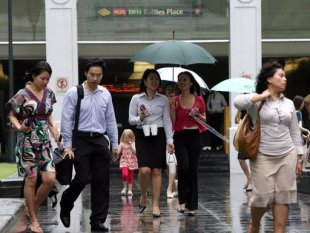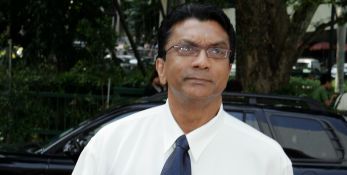Who opened the floodgates to immigrants?
By Seah Chiang Nee | SingaporeScene – Wed, Nov 16, 2011

Office workers walk out for lunch at the financial district in Singapore in 2008. (AFP photo)
Who opened the floodgates in Singapore that let in three new waves of immigrants during the past 24 years?
Most Singaporeans probably feel they know the answer but at least one serious analyst has pointed the finger, not at their influential ex-Minister Mentor, but at Emeritus Senior Minister Goh Chok Tong.
Although a few people had privately talked about it, this was the first time it was articulated publicly that the mild-mannered Goh's role was more than a passive one.
A regular contributor on the republic's history and current affairs, Chua Suntong wrote in The Online Citizen that Goh was the starting force behind the influx of foreign PRs.
The ill-prepared policy, one of modern Singapore's most important, has been the cause of a number of problems for locals, ranging from jobs and public transport to housing and education.
It also led to one of the worst election declines for the ruling party.
In his article, Chua said that as Singapore's fertility rate fell to 1.4 in 1987, Goh — who was then Deputy Prime Minister and due to succeed Lee Kuan Yew — started a pro-immigration policy.
Chua, who describes himself as a home-grown Singaporean, is a regular commentator on finance, history, languages and logistics.
Pointing the finger
He alleged it was Goh who had openly promoted mass immigration in 1987 when he was DPM. There has been no official confirmation from the two retired leaders.
During the past 20 years (1991-2010) some 726,768 PR permits were issued — mostly to foreign professionals, managers, executives and technicians (PMETs), who were directly competing with middle-class Singaporeans.
"Goh regularly used the term 'foreign talents' (FTs) to describe foreign PMETs and foreign-born students in local higher-level academic institutions," the columnist said.
At one time, he also strongly nudged as many PRs as possible to take up Singapore citizenship.
Chua's article was an analysis of the "Sept 2011 Population Report in the Larger Context" issued by the Institute of Policy Studies (IPS), a think tank.
"After promoting foreign immigration without really defining its meaning from 1987 to 2011, the ESM relinquished his Cabinet position," Chua wrote.
"He expressed hopes that a younger Cabinet would be able to carry Singapore forward in a more difficult and complex situation. His policies probably caused this situation."
The IPS report attributed no names of leaders responsible, but the writer indicated several times that Goh had been pushing it for a long period.
Several waves
It opened the door for 20,000-plus new PRs a year from 1987 to 1997 (up from 8,000 average). The figures rose steadily in two more waves until 2005-2010 when between 50,000 and 80,000 arrived every year.
"The ESM remained in the Cabinet after stepping down from the prime ministership in 2004," Chua added. The tempo of PR arrivals increased.
What he said of the role of the former well-liked Prime Minister has come as a surprise to Singaporeans, who had all along believed the immigration policy was solely Lee's idea.
Chua said that even after he handed over leadership to PM Lee Hsien Loong, he had continued to work on the programme as Senior Minister, and PRs kept coming in.
In another comment, social activist Ravi Philemon also said that it was the government under Goh which relaxed the stricter yester-years immigration policy of Singapore.
In fact, the excessive arrivals resulted in Lee Kuan Yew warning him that 60,000 new residents a year was "politically indigestible" and that 30,000 was more realistic.
Singaporeans generally read with some disbelief that Lee had allowed such an important decision as mass immigration to be decided by Goh.
The majority of informed Singaporeans still feel the original initiative had come from the founding leader himself — and that Goh was only a very convinced implementer.
A minority opinion, however, was that Goh and, subsequently, Prime Minister Lee Hsien Loong were just carrying out Lee's ambition to have a six million to seven million population by 2030.
Setting the record straight
At that time, Lee had frequently been telling people that his successors were calling the shots and running Singapore and that he was merely — as Minister Mentor — giving advice on the side. It wasn't always taken seriously.
"The truth will emerge one day as to who really made the call to let in so many foreign settlers without adequate preparation," said a retired businessman and strong admirer of Lee.
"In the event that Lee was only minimally responsible for the excess, then it is good that someone puts it on record before he passes on. Otherwise, it will not be fair to him."
That was a period when most People's Action Party (PAP) leaders were pro-immigration, including both the two Lees. It is only now that the numbers are being cut back.
Lee Senior had said it allowed Singapore "to punch above its weight". The difference was, of course, how big a figure.
Three years ago, Lee signalled a redirection, saying he now preferred an optimum population of 5.5 million — instead of 6.5 million.
Others like former PAP MP Dr Tan Hui Heng had even called for a "big bang" approach in doubling manpower.
Tan, in fact, suggested admitting not only the highly talented, but also those with lower and intermediate skills, arguing that a big bang approach would prevent erosion of asset values.
The new young arrivals, Goh had hoped, would make up for Singapore's baby shortfall.
The story has not ended. More foreign PRs will likely arrive in this migrant society — but staggered over a longer period.
A former Reuters correspondent and newspaper editor, the writer is now a freelance columnist writing on general trends in Singapore. This post first appeared on his blog www.littlespeck.com on 12 November 2011.
By Seah Chiang Nee | SingaporeScene – Wed, Nov 16, 2011

Office workers walk out for lunch at the financial district in Singapore in 2008. (AFP photo)
Who opened the floodgates in Singapore that let in three new waves of immigrants during the past 24 years?
Most Singaporeans probably feel they know the answer but at least one serious analyst has pointed the finger, not at their influential ex-Minister Mentor, but at Emeritus Senior Minister Goh Chok Tong.
Although a few people had privately talked about it, this was the first time it was articulated publicly that the mild-mannered Goh's role was more than a passive one.
A regular contributor on the republic's history and current affairs, Chua Suntong wrote in The Online Citizen that Goh was the starting force behind the influx of foreign PRs.
The ill-prepared policy, one of modern Singapore's most important, has been the cause of a number of problems for locals, ranging from jobs and public transport to housing and education.
It also led to one of the worst election declines for the ruling party.
In his article, Chua said that as Singapore's fertility rate fell to 1.4 in 1987, Goh — who was then Deputy Prime Minister and due to succeed Lee Kuan Yew — started a pro-immigration policy.
Chua, who describes himself as a home-grown Singaporean, is a regular commentator on finance, history, languages and logistics.
Pointing the finger
He alleged it was Goh who had openly promoted mass immigration in 1987 when he was DPM. There has been no official confirmation from the two retired leaders.
During the past 20 years (1991-2010) some 726,768 PR permits were issued — mostly to foreign professionals, managers, executives and technicians (PMETs), who were directly competing with middle-class Singaporeans.
"Goh regularly used the term 'foreign talents' (FTs) to describe foreign PMETs and foreign-born students in local higher-level academic institutions," the columnist said.
At one time, he also strongly nudged as many PRs as possible to take up Singapore citizenship.
Chua's article was an analysis of the "Sept 2011 Population Report in the Larger Context" issued by the Institute of Policy Studies (IPS), a think tank.
"After promoting foreign immigration without really defining its meaning from 1987 to 2011, the ESM relinquished his Cabinet position," Chua wrote.
"He expressed hopes that a younger Cabinet would be able to carry Singapore forward in a more difficult and complex situation. His policies probably caused this situation."
The IPS report attributed no names of leaders responsible, but the writer indicated several times that Goh had been pushing it for a long period.
Several waves
It opened the door for 20,000-plus new PRs a year from 1987 to 1997 (up from 8,000 average). The figures rose steadily in two more waves until 2005-2010 when between 50,000 and 80,000 arrived every year.
"The ESM remained in the Cabinet after stepping down from the prime ministership in 2004," Chua added. The tempo of PR arrivals increased.
What he said of the role of the former well-liked Prime Minister has come as a surprise to Singaporeans, who had all along believed the immigration policy was solely Lee's idea.
Chua said that even after he handed over leadership to PM Lee Hsien Loong, he had continued to work on the programme as Senior Minister, and PRs kept coming in.
In another comment, social activist Ravi Philemon also said that it was the government under Goh which relaxed the stricter yester-years immigration policy of Singapore.
In fact, the excessive arrivals resulted in Lee Kuan Yew warning him that 60,000 new residents a year was "politically indigestible" and that 30,000 was more realistic.
Singaporeans generally read with some disbelief that Lee had allowed such an important decision as mass immigration to be decided by Goh.
The majority of informed Singaporeans still feel the original initiative had come from the founding leader himself — and that Goh was only a very convinced implementer.
A minority opinion, however, was that Goh and, subsequently, Prime Minister Lee Hsien Loong were just carrying out Lee's ambition to have a six million to seven million population by 2030.
Setting the record straight
At that time, Lee had frequently been telling people that his successors were calling the shots and running Singapore and that he was merely — as Minister Mentor — giving advice on the side. It wasn't always taken seriously.
"The truth will emerge one day as to who really made the call to let in so many foreign settlers without adequate preparation," said a retired businessman and strong admirer of Lee.
"In the event that Lee was only minimally responsible for the excess, then it is good that someone puts it on record before he passes on. Otherwise, it will not be fair to him."
That was a period when most People's Action Party (PAP) leaders were pro-immigration, including both the two Lees. It is only now that the numbers are being cut back.
Lee Senior had said it allowed Singapore "to punch above its weight". The difference was, of course, how big a figure.
Three years ago, Lee signalled a redirection, saying he now preferred an optimum population of 5.5 million — instead of 6.5 million.
Others like former PAP MP Dr Tan Hui Heng had even called for a "big bang" approach in doubling manpower.
Tan, in fact, suggested admitting not only the highly talented, but also those with lower and intermediate skills, arguing that a big bang approach would prevent erosion of asset values.
The new young arrivals, Goh had hoped, would make up for Singapore's baby shortfall.
The story has not ended. More foreign PRs will likely arrive in this migrant society — but staggered over a longer period.
A former Reuters correspondent and newspaper editor, the writer is now a freelance columnist writing on general trends in Singapore. This post first appeared on his blog www.littlespeck.com on 12 November 2011.
Last edited:




 :oIo:
:oIo: